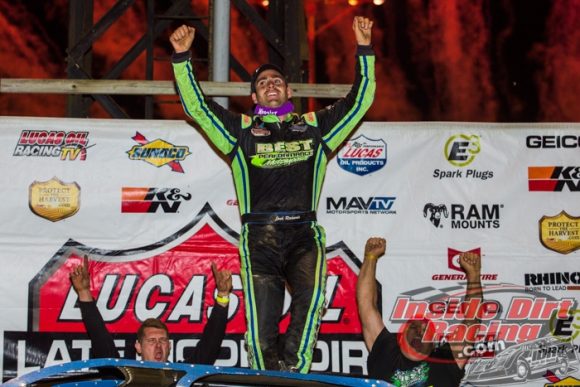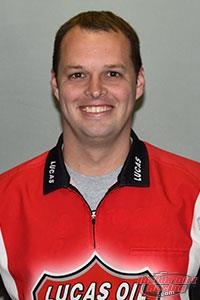
Tim McCreadie(39) and Jonathan Davenport(49) have combined to win four of the last five Lucas Oil titles
In 2003, Matt Kenseth pieced together such a consistent season that he had already secured the NASCAR Cup Series championship before the final race of the year at the Homestead-Miami Speedway had even taken the green flag. During the following off-season, the sanctioning body and its partners immediately took steps to see that such a thing would not happen again. Thus, the Chase for the Championship system, which would take the top-10 drivers in the standings and re-set their point totals for a final stretch run to the finale, was born. The purpose of this playoff format was to assure a battle for the championship that would go right down to the wire and build interest for a sport that had become increasingly reliant on television revenue.
The current NASCAR Playoffs system now provides an opportunity for sixteen drivers to have a chance at winning the title. During the final ten races of the Cup Series season, eliminations cut the field from sixteen drivers to twelve after the first three races then down to eight competitors after the next set of three events and eventually to the ‘Championship 4’ after another trio of shows for a winner-take-all finale in which the highest finisher of those remaining contenders is awarded the championship.
This past season, Tim McCreadie earned his second consecutive Lucas Oil Late Model Dirt Series championship when he bested Brandon Sheppard by 275 points. In the previous campaign, McCreadie topped Hudson O’Neal by an astounding 540 markers.
The average margin of victory by each Lucas Oil champion over the past five years has been 390 points. Those seasons have not exactly produced nail-bitter type finishes.
The last time a LOLMDS championship was decided by less than 100 points was in 2017 when Josh Richards beat out McCreadie by 65.
On Thursday, the Lucas Oil Late Model Dirt Series took steps toward producing a closer title fight when it announced what will be known as the ‘Big River Steel Chase for the Championship presented by ARP’. This new format will ensure a down-to-the-wire completion to the campaign when the tour contests its season-ending race in the Dirt Track World Championship at the Eldora Speedway in Rossburg, Ohio on October 21, 2023.
NASCAR devised its Chase/Playoffs system shortly after it had received a massive television rights package from its broadcast partners. With the investment in the sport, those partners believed they had earned the right to offer suggestions as to how individual races and the championship would be contested. As a result, the networks were given a system that would ensure the likelihood of a close battle to the end.
In a somewhat similar way, the Lucas Oil tour may very well have wanted or needed to produce a system that would keep the championship battle relevant and intriguing to the very end because of the series increased presence on television and streaming broadcasts. Cable network MavTV has shown many of the LOLMDS events either live or on a delayed basis while every race is aired live by streaming partner FloRacing.com.
It is no doubt easier to sell advertising space when the broadcaster can assure the potential sponsor that there will be a reason for fans to tune in all the way through the final feature of the season.
The dirt racing version of the Chase for the Championship will start off with fifteen drivers making the initial cut based on the series point standings through the Show-me 100 held at the Lucas Oil Speedway in Wheatland, Missouri on May 27th. The points leader at that time will receive $2,500 with the remaining 14 also earning reward money.
The second cut will take place following the Diamond Nationals at the Lucas Oil Speedway on July 15th which will leave twelve hopefuls still alive. The standings leader at that time will receive a payout of $5,000 with the other 11 also picking up extra cash.
The title-seeking field will be cut to eight participants after the checkered flag waves over the Rumble by the River at Pennsylvania’s Port Royal Speedway on August 26th. The points leader at that time will secure a $7,500 payday with the remaining seven also earning rewards.
The field will be cut to four following the Pittsburgher at Pittsburgh’s Pennsylvania Motor Speedway on September 30th with the standings front runner taking home $10,000 for his efforts up to that point while the other three drivers will each be handed $2,000.
The championship-deciding Dirt Track World Championship will see the crowning of the Lucas Oil Late Model Dirt Series title winner. The highest finishing competitor among those final four drivers, no matter where he finishes, will be the champion.
In the press release announcing the move, Lucas Oil Series Director Rick Schwallie explained the change in format.
“The Lucas Oil Late Model Dirt Series has seen tremendous growth throughout its history,” Schwallie declared. “As we look ahead to our 19th season, we’re ready for an action-packed season that will culminate in our first ever visit to the historic Eldora Speedway. Only twice in our history has the championship been contested at the season finale. The Dirt Track World Championship is an event that is worthy of crowning a champion. Not only will the crown jewel pay $100,000 to win, but now, the race inside the race is worthy of the persona that is the Dirt Track World Championship.”
The final points fund payout will go as follows:
- $200,000
- $150,000
- $125,000
- $100,000
- $75,000
- $60,000
- $50,000
- $45,000
- $40,000
- $35,000
- $30,000
- $25,000
In an era that is seeing more and more big features contested over a number of different series, more drivers and teams are opting to race a so-called “outlaw” schedule rather than focus their efforts on one particular tour. A system such as this could help the Lucas Oil Late Model Dirt Series to lock in more drivers because the significant amount of money being awarded throughout the top-12 in the final standings as well as throughout the Chase following each cut.
Another potential benefit of employing a system such as this is the “wow factor” that could be created. Those season defining moments such as when Ross Chastain made a bold move on the final lap at Martinsville Speedway to gain entry into NASCAR’s Championship 4 drew lots of attention. That move stirred more interest on social media than anything else to have occurred in sports on that particular weekend.
Although Dirt Late Model racing most likely would not bring about a moment of that magnitude, a daring late race move to advance to the next round could draw attention at least across the motorsports industry.
One thing that will not change, however, is the fact that the individual races will still matter. Dirt racing has long been a sport in which drivers and teams compete against each other to be the best at a particular track on a particular evening. One intriguing aspect of this sport has always been that of the series regulars racing against the invaders who only drop in at certain tracks in an attempt to snare the top payout. That won’t change no matter what the championship format might be.
Schwallie detailed the positives of the change.
“For us to be proud of this program, there were two key factors,” he said. “First, the event needed to be contested at the speedway that dirt late model racing calls home, Eldora. Second, the four finalists contending for a national title needed to be well compensated for their efforts all season. The unwavering dedication of Lucas Oil, our exclusive broadcast partner FloRacing, and our great marketing partners allow us to strive as the elite dirt late model tour.”
The comparisons to NASCAR are inevitable. Many dirt racing fans will immediately form a negative opinion of the Lucas Oil Late Model Dirt Series Chase for the Championship because of the similarities to that form of racing. And it would be difficult to deny the similarities. Just how deep that impact will be is a question to be answered in the future.
When I first heard of the idea for NASCAR’s Chase for the Championship, I thought it was one of the worst ideas ever. But now, I have grown to enjoy the current version of the NASCAR Playoffs. In one sense, I am still not completely convinced this is a format that can have the same impact in Dirt Late Model racing as it has had for NASCAR, but in another way, I want to avoid rushing to judgement and wait to see what happens.
Please consider also reading:
Respond to this post on Twitter by following @RichardAllenIDR and @MichaelRMoats or by liking the InsideDirtRacing.com Facebook page.
Also, NASCAR and pavement racing fans can check out InsideCircleTrack.







